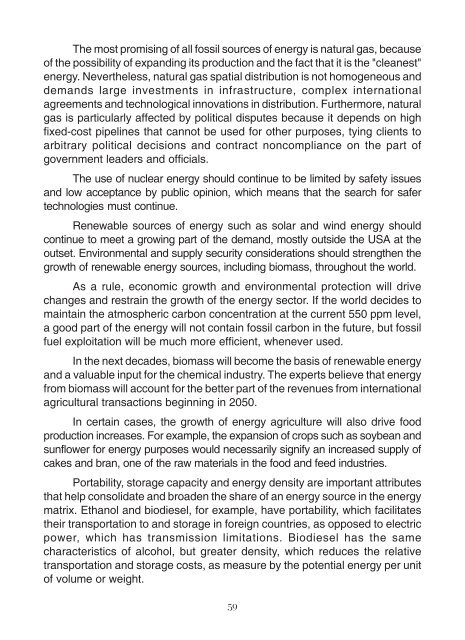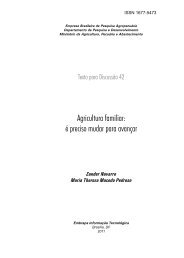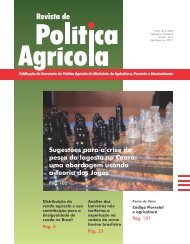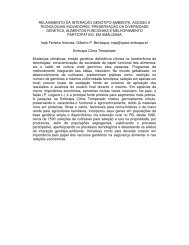Ministry of Agriculture, Livestock and Food Supply - Embrapa
Ministry of Agriculture, Livestock and Food Supply - Embrapa
Ministry of Agriculture, Livestock and Food Supply - Embrapa
You also want an ePaper? Increase the reach of your titles
YUMPU automatically turns print PDFs into web optimized ePapers that Google loves.
The most promising <strong>of</strong> all fossil sources <strong>of</strong> energy is natural gas, because<br />
<strong>of</strong> the possibility <strong>of</strong> exp<strong>and</strong>ing its production <strong>and</strong> the fact that it is the "cleanest"<br />
energy. Nevertheless, natural gas spatial distribution is not homogeneous <strong>and</strong><br />
dem<strong>and</strong>s large investments in infrastructure, complex international<br />
agreements <strong>and</strong> technological innovations in distribution. Furthermore, natural<br />
gas is particularly affected by political disputes because it depends on high<br />
fixed-cost pipelines that cannot be used for other purposes, tying clients to<br />
arbitrary political decisions <strong>and</strong> contract noncompliance on the part <strong>of</strong><br />
government leaders <strong>and</strong> <strong>of</strong>ficials.<br />
The use <strong>of</strong> nuclear energy should continue to be limited by safety issues<br />
<strong>and</strong> low acceptance by public opinion, which means that the search for safer<br />
technologies must continue.<br />
Renewable sources <strong>of</strong> energy such as solar <strong>and</strong> wind energy should<br />
continue to meet a growing part <strong>of</strong> the dem<strong>and</strong>, mostly outside the USA at the<br />
outset. Environmental <strong>and</strong> supply security considerations should strengthen the<br />
growth <strong>of</strong> renewable energy sources, including biomass, throughout the world.<br />
As a rule, economic growth <strong>and</strong> environmental protection will drive<br />
changes <strong>and</strong> restrain the growth <strong>of</strong> the energy sector. If the world decides to<br />
maintain the atmospheric carbon concentration at the current 550 ppm level,<br />
a good part <strong>of</strong> the energy will not contain fossil carbon in the future, but fossil<br />
fuel exploitation will be much more efficient, whenever used.<br />
In the next decades, biomass will become the basis <strong>of</strong> renewable energy<br />
<strong>and</strong> a valuable input for the chemical industry. The experts believe that energy<br />
from biomass will account for the better part <strong>of</strong> the revenues from international<br />
agricultural transactions beginning in 2050.<br />
In certain cases, the growth <strong>of</strong> energy agriculture will also drive food<br />
production increases. For example, the expansion <strong>of</strong> crops such as soybean <strong>and</strong><br />
sunflower for energy purposes would necessarily signify an increased supply <strong>of</strong><br />
cakes <strong>and</strong> bran, one <strong>of</strong> the raw materials in the food <strong>and</strong> feed industries.<br />
Portability, storage capacity <strong>and</strong> energy density are important attributes<br />
that help consolidate <strong>and</strong> broaden the share <strong>of</strong> an energy source in the energy<br />
matrix. Ethanol <strong>and</strong> biodiesel, for example, have portability, which facilitates<br />
their transportation to <strong>and</strong> storage in foreign countries, as opposed to electric<br />
power, which has transmission limitations. Biodiesel has the same<br />
characteristics <strong>of</strong> alcohol, but greater density, which reduces the relative<br />
transportation <strong>and</strong> storage costs, as measure by the potential energy per unit<br />
<strong>of</strong> volume or weight.<br />
59












